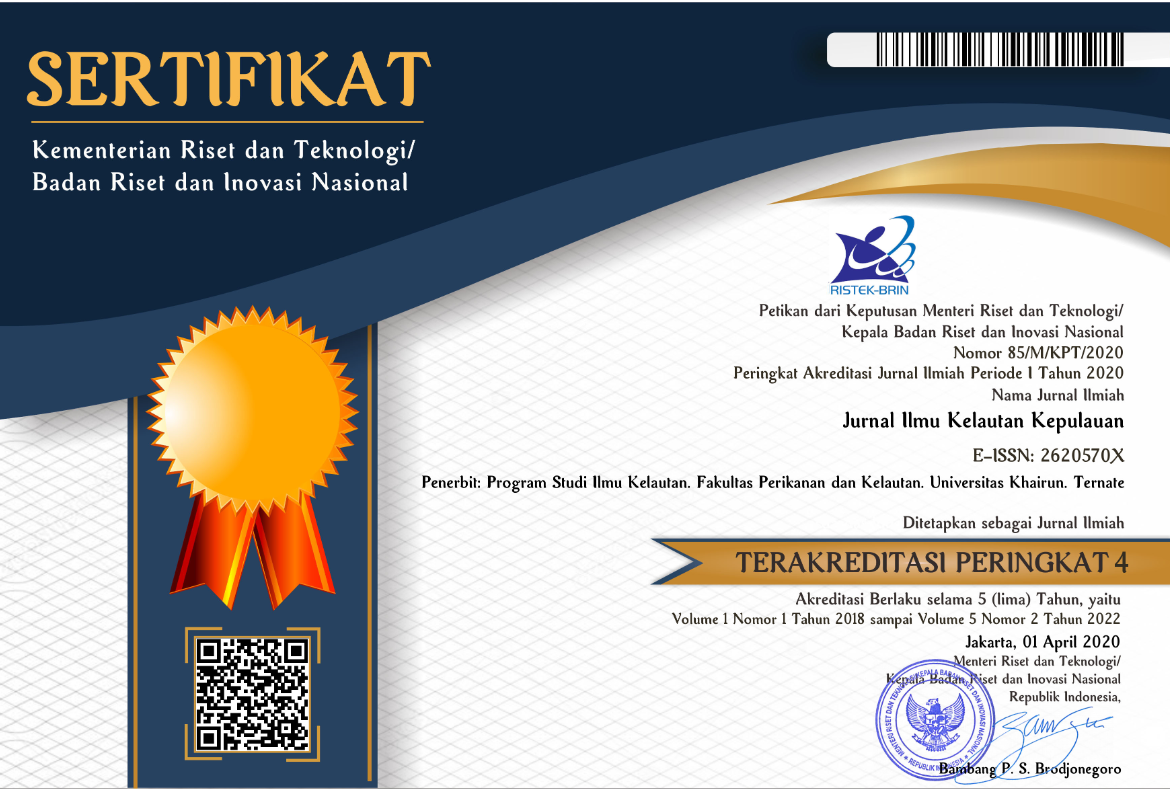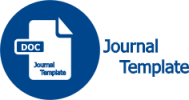Kondisi megabentos di perairan Kabupaten Sumba Timur, Provinsi Nusa Tenggara Timur
Abstract
Terumbu karang merupakan habitat penting bagi berbagai biota yang hidup berasosiasi di dalamnya. Beberapa jenis megabentos mendiami terumbu karang memiliki nilai ekologis dan ekonomis penting, sehingga dapat dijadikan sebagai indikator untuk menilai kesehatan terumbu. Penelitian megabentos di perairan Pulau Sumba, Kabupaten Sumba Timur dilakukan Oktober 2018. Tujuan penelitian untuk mengetahui kondisi megabentos di perairan Sumba Timur. Pengambilan sample menggunakan metode Benthos Belt Transect yang dimodifikasi dari Belt Transect Method. Hasil analisis menunjukkan nilai kepadatan individu di setiap stasiun berkisar dari 0,14-0,74 individuals/m2, dengan Diadema spp. memiliki kepadatan tertinggi (2,62 individu/m2), diikuti Drupella spp. (1,06 individu/m2), kemudian Panulirus spp. dan Linckia laevigata memiliki kepadatan terendah (0,01 individu/m2). Nilai indeks keanekaragaman (H’) berkisar antara 0,45-1,18, indeks kemerataan jenis (J’) berkisar antara 0,32-0,82 dan indeks dominasi (D) berkisar antara 0,35-0,81. Secara umum, kondisi megabentos diperairan Kabupaten Sumba Timur berada dalam kategori rendah hingga sedang.
Kata kunci: Kondisi, megabentos, terumbu karang, Sumba Timur
Full Text:
130-146 (Bahasa Indonesia)References
Abbott R.T. and P. Dance. 1990. Compendium of Seashell. Australia. Crawford House Press. 411 pp.
Arbi, U.Y, A. Harahap and H.A.W. Cappenberg, 2020. Fluktuasi kondisi megabentos di perairan Ternate MalukuUtara. Jurnal Kelautan Trpis. Vol. 23 (1): 57 – 72.
Arthur M.R.H. 1972. Geographycal ecology pattern in the distribution species. Harper and Row. Publish. New York. 260pp.
Ayling A.M. and A.L. Ayling. 1987. Ningaloo Marine Park: preliminary fish density assessment and habitat survey, with information on coral damage due to Drupella grazing, Report to the Department of Conservation and Land Management, Western Australia.
Aziz A. 1994. Tingkah laku bulu babi di padang lamun. Oseana. P30-LIPI. Jakarta. 14(4): 35 – 43.
Aziz A. 1996. Makan dan cara makan berbagai jenis bintang laut. Oseana. P30-LIPI. Jakarta, 21(3): 13 – 22.
“JURNALILMUKELAUTANKEPULAUANâ€Â
Barco A, M. Claremont, D.G. Reid, R. Hobart, P.. Bouchet, S.T. Williams, C. Cruaud, A, Couloux and M. Oliverio. 2010. A molecular phylogenetic framework for the Muricidae, a diverse family of carnivorous gastropods. Mol Phylogenet Evol. 56:1025–1039.
Black R. and M. S. Johnson. 1994. Growth Rates in Outbreak Population of The Corallivorous Gastropoda Drupella Cornus (Roding 1798) at Ningaloo Reef, western Australia. Coral reff 13:145 – 150.
Boss, A.R, Alipoyo, J.C, Cardona, L.T, Gumanao, G.S, and Salac, F.N, 2008. Population structure of common IndoPacific sea stars in the Davao Gulf, Philippines. UPVJournal of Natural Science, 13, 11-24.
Bozec, Y, L. Alvarez-Filip, and P. J. Mumby. (2015). The dynamics of architectural complexity on coral reefs under climate change. Global Change Biol. 21, 223–235.
Brower, J.E, J.H. Zar, and C.N. von Ende. 1998. Field and Laboratory Methods for General Ecology. Fourth. USA: Mc.Graw-Hill Companies Inc.
Cappenberg H.A.W. 2014. Struktur komunitas megabentos di Perairan Pangkajene Kepulauan, Kabupaten Pangkep, Sulawesi Selatan. Zoo Indonesia 2014. 23(2):57-67.
Cappenberg H.A.W. dan R.T. Mahulette. 2019. Sebaran dan kepadatan megabentos di perairan Pulau Buton, Sulawesi Tenggara. BAWAL. II (2): 79 – 93.
Clark A.M. and F.W.E. Rowe. 1971. Monograph of shallow-water Indo-west Pasific Echino- derms. Trustees of the British Muse- um (Nat. Hist.). London : 238 pp.
Collin P.L. and C. Arnesson 1995. Tropical Pasific Invertebrates. Coral Reef Prees, California: 209 pp. Conand C. 1989. Les holothuries aspidochirotes du lagon de Nouvelle-Calédonie: Biologie, écologie et exploitation. Etudes et thèses ORSTOM, Paris Conand C. and P. Chardy. 1985. Are the aspidochirote holothurians of the New Caledonian lagoon good indicators of the reefal features? In: Proc 5th Int Coral Reef Congr, Vol 5. Antenne Museum−EPHE, Moorea, Tahiti. 291−296.
Cumming R.L. and D. McCorry. 1998. Corallivorous gastropods in Hong Kong. Coral Reef 17:78.
Daget, J. 1976. Les Modeles Mathematique En Ecologie. Masson Coll. Ecoll. 8: 172 pp.
Dance P. 1976. The collector’s encyclopedia of shell. New Jersey. Cartwell Book Inc. 288 pp.
Dean H.K. (2008). The use of polychaetes (Annelida) as indicator species of marine pollution: a review. Int J Trop Biol 56 (4): 11-38.
De Beer M. 1990. Distribution patterns of regular sea urchins (Echinodermata: Echinnoides) cross the Spermonde shelf, SW Sulawesi (Indonesia). In De Ridder, Dubois, Lahaye and Jangoux (Eds.). Proceedings of the second European conference on echinoderms Brussels,Belgium, 18 – 21 September 1989 (p.165-169). Leiden: National Museum of National History.
Dharma, B. 2005. Resent and fossil Indonesia shell. Conchbook, Hackenheim. Germany. 424 pp.
Diaz-Pulido, G. and L.J. McCook. 2008. Macroalgae (Seaweed) in China, the State of Great Barrier Reef On-line. Great Barrier Reef Marine Park Authority, Townsville.
Dissanyake D.C.T. and G. Stefansson. 2012. Habitat preference of sea cucumbers: Holothuria atra and Holothuria edulis in the coastal waters of Sri Lanka. J Mar Biol Assoc UK 92:581–593.
Dupont, S, O. Ortega-Martinez, dan M. Thorndyke. 2010. Impact of near-future ocean acidification on echinoderms. Ecotoxicology, 19(3): 449-462.
Fabricius, K. E, G. De’ath, S. Noonan, and S. Uthicke. 2013. Ecological effects of ocean acidification and habitat complexity on reef-associated macroinvertebrate communities. P. Roy. Soc. B-Biol. Sci 281, 20132479.
Gabbi G. 1999. Shells: Guide to the jewels of the sea. Turin: Periplus. 168 pp.
Ghafari, M.I.A, G. Hadiprayitno, M.L. Ilhamdi, dan N.M. Satyawan. 2019. Struktur komunitas Echinodermata di kawasan intertidal Gili Meno, Lombok Utara. ALKAUNIYAH:Jurnal Biologi, 12(2): 181-188.
Giyanto, A.E. Manuputty, M. Abrar, R.M. Siringoringo, S.R. Suharti, dan K. Wibowo. K, . 2014. Panduan Monitoring Kesehatan Terumbu Karang. Terumbu Karang, Ikan Karang, Megabenthos dan Penulisan Laporan. (Suharsono, dan O.K. Sumadhiharga, Eds.). Jakarta: COREMAP CTI LIPI.
Gomez, E.D. and A.C. Alcala. 1978. Stastus of Philiphina coral reef. Project, Int. Symp.Biogeogr. Evol. S. Hem. Auckland New Zealand, 17 - 20 July 1978. 2: 663-669.
Ham, Y. 2018. El Niño events set to intensify. Nature 564, 192–193.
Hartati, S. T. dan Awwaluddin. 2007. Struktur komunitas makrozoobentos di perairan Teluk Jakarta. Perikanan Indonesia. 13 (2):105–124.
Hoegh-Guldberg, O, P.J. Mumby, A.J. Hooten, R.S. Steneck, P. Greenfield, and E.Gomez, 2007. Coral reefs under rapid climate change and ocean acidification. Science 318, 1737–1742.
Hoeksema B.W, C. Scott, and J.D. True. 2013. Dietary shift in corallivorous drupella snails following a major bleaching event at Koh Tao Gulf of Thailand. Coral Reef : 1 – 6.
Hughes, T.P, J.T. Kerry, A.H. Baird, S.R. Connolly, A. Dietzel, and C.M. Eakin. 2018. Global warming transforms coral reef assemblages. Nature 556,492–526.
Iken K, Konar, B, Benedetti-Cecchi, L, Cruz-Motta, J.J, Knowlton, A, Pohle, G, Mead A, Iloslavich P, Wong M. and Trott T. 2010. Large-scale spatial distribution patterns of echinoderms in nearshore rocky habitats. PLoS ONE. 5(11):e13845.
Jimenez H, P. Dumas, D. Ponton, J. Ferraris 2012. Predicting Invertebrate Assemblage Composition from Harvesting Pressure and Environmental Characteristics on Tropical Reef Flats. Coral Reefs 31:89–100.
Kekenusa J.S. (1993). Pola penyebaran, keanekaragaman dan asosiasi antara species teripang di pesisir pantai barat Pulau Nain, Sulawesi Utara. Jurnal Fakultas Perikanan UNSRAT, 11(4): 11-17.
Kröncke, I, and H. Reiss. 2010. Influence of macrofauna longterm natural variability on benthic indices used in ecological quality assessment. Marine Pollution Bulletin, 60(1), 58-68. DOI: 10.1016/j.marpolbul.2009.09.001.
Manuputty A.E.W, Giyanto, Winardi, Suharti, A.R. and Djuwaria. 2006. Manual Monitoring kesehatan karang (Reef health monitoring). Jakarta: LIPI.
Nybakken J.W. 1992. Biologi laut, suatu pendekatan ekologi. PT. Gramedia Pustaka Utama. Jakarta. 496 hal.
Odum, E.P. 1971. Fundamental of ecology. W. E. Sunders, Philadelphia : 574 hlm.
Pirzan A.M. dan P.R. Pong-Masak. 2008. Hubungan Keragaman Fitoplankton dengan Kualitas Air di Pulau Bauluang, kabupaten Takalar, Sulawesi Selatan. Biodiversitas. Vol. 9 (3) : 217-221.
Poutiers J. 1998. The Living Marine Resources of The Western Central Pasific. Vol.1: Seaweeds, corals, bivalves and gastropods. FAO of The United Nation. 686 pp.
Przeslawski, R, S. Ahyong, M. Byrne, G. Worheides, and P. Hutchings. 2008. Beyond corals and fish: the effects of climate change on noncoral benthic invertebrates of tropical reefs. Global Change Biol. 14, 2773–2795. Sahidin A, dan Y Wardiatno. 2016. Spatial distribution of Polychaete at Tangerang coastal water, Banten Province. J Fish Mar 6 (2): 83-94.
Shafir, S, O. Gur, and B. Rinkevich. 2008. A Drupella cornus outbreak in the northern Gulf of Eilat and changes in coral prey. Coral Reefs, 27(2): 379-379.
Sharif S. and B. Rinkevich. 2008. A Drupella cornus outbreaks in the northen Gulf of Eilat and changes in coral prey. Coral Reef 27: 379.
Sharma, S.D, R.R. Behera, U. Mohapatra, C.R. Panda, and L. Nayak. 2018. Effect of estuarine effluents on benthic faunal communities in relations to tidal dynamics of Dhamra estuary. World Journal of Pharmaceutical and Life Sciences, 4(2), 127-134. Shiell G.R. and B. Knott. 2008. Diurnal observations of sheltering behaviour in the coral reef sea cucumber Holothuria whitmaei. Fish Res 91: 112−117. Shiell G.R. and B. Knott. 2010. Aggregations and temporal changes in the activity and bioturbation contribution of the sea cucumber Holothuria whitmaei (Echinodermata: Holothuroidea). Mar Ecol Prog Ser 415: 127−139. Shokat P, S.M.B. Nabavi, A. Savari, and P. Kochanian. 2010. Ecological quality of Bahrekan coast, by using biotic indices and benthic communities. Transit. Waters Bull 4 (1): 25-34 Slater M.J. and A.G. Jeffs. 2010. Do benthic sediment characteristics explain the distribution of juveniles of the deposit-feeding sea cucumber Australostichopus mollis? J Sea Res 64: 241−249.
Stark, J.S, Kim, S.L, and Oliver, J.S, 2014. Anthropogenic disturbance and biodiversity of marine benthic communities in Antartica: A regional comparison. PloS One, 9(6): 1 – 24.
Suharsono. 2008. Jenis-Jenis Karang di Indonesia. LIPI Press, Jakarta. 344 hlm.
Tabatabaie T. and F. Amiri. 2011. Evaluation of the impact of industrial sewage pollution on marine benthic communities. Journal of Water Supply: Res Technolâ€â€AQUA 60 (6): 364-374.
Turner S.J. 1994. The biology and population outbreaks of the coalliovorous gastropods drupella on Indo-Pacific Reefs. Oceanogr. Mar. Biol. Ann. Rev. 32: 461 – 530. Tuya F, J.C. Hernández and S. Clement. 2006. Is there a link between type of habitat and the patterns of abundance of holothurians in shallow rocky reefs? Hydrobiologia 571:191−199. Uthicke S. and R. Karez. 1999. Sediment patch selectivity in tropical sea cucumbers (Holothuroidea: Aspidochirotida) analysed with multiple choice experiments. J Exp Mar Biol Ecol 236: 69−87.
Vimono I. B. 2007. Sekilas mengenai landak laut. Oseana XXXII(3): 15 – 21.
Warwick, R.M. and Clarke, K.R. 2001. Change in marinre communities: an approach to statistical analysis and interpretation. Plymouth, Natural Environmental Research Council : Bourne Press.
Wilson B. 1993. Australian Marine Shells. Vol. I. Western Australia: Odyssey Publishing. 406 pp.
Yuan, X, S. Shao, X. Yang, D. Yang, Q. Xu, and H. Zong. 2016. Bioenergetic trade-offs in the sea cucumber Apostichopus japonicus (Echinodermata: Holothuroidea) in response to CO2-driven ocean acidification. Enveronmental Science and Pollution Research, 23(9): 8453-8461.
DOI: https://doi.org/10.33387/jikk.v3i2.2582
Refbacks
- There are currently no refbacks.
Â
Â
Â
 | Address : Marine Science Study Program, Faculty of Fisheries and Marine Science - Khairun University, Ternate, North Maluku, Indonesia |






